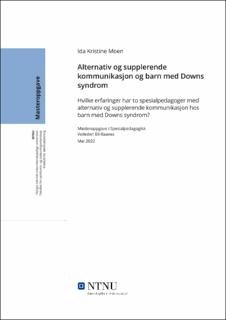| dc.contributor.advisor | Raanes, Eli | |
| dc.contributor.author | Moen, Ida Kristine | |
| dc.date.accessioned | 2022-07-23T17:21:26Z | |
| dc.date.available | 2022-07-23T17:21:26Z | |
| dc.date.issued | 2022 | |
| dc.identifier | no.ntnu:inspera:111681752:25708693 | |
| dc.identifier.uri | https://hdl.handle.net/11250/3008052 | |
| dc.description.abstract | Denne studien gir et innblikk i to spesialpedagoger sine erfaringer knyttet til bruk av alternativ og supplerende kommunikasjon (ASK) hos barn med Downs syndrom. Dette ut fra temaet kommunikasjon i møte med barn med Downs syndrom. Problemstillingen som danner utgangspunktet for studien, er:
Hvilke erfaringer har to spesialpedagoger med alternativ og supplerende kommunikasjon hos barn med Downs syndrom?
Jeg har utarbeidet to forskningsspørsmål for å avgrense og belyse problemstillingen. Forskningsspørsmålene omhandler hvordan ASK bidrar til å støtte kommunikasjon, og hvordan elevene kommuniserer med sine kommunikasjonspartnere. Studien baseres på en kvalitativ forskningsmetode, hvor intervju blir brukt som datainnsamlingsmetode. Informantene i denne studien er to spesialpedagoger med erfaringer i bruk av ASK hos barn med Downs syndrom. Studiens teorigrunnlag tar for seg begrepene kommunikasjon, alternativ og supplerende kommunikasjon og Downs syndrom.
Studiens funn viser at ASK støtter kommunikasjonsevnen gjennom at elevens språk blir mer forståelig for kommunikasjonspartnere. I tillegg bidrar ASK til større oppmerksomhet hos eleven, da ASK er en visuell måte å kommunisere på. Videre funn viser at ASK hjelper elevene med å kunne påvirke andre i form av å for eksempel utføre en handling, samt at det er behov for ASK selv om eleven selv ikke uttrykker seg ved hjelp av dette. Elevene i denne studien har forskjellig tilnærming til ASK, som viser til ulike måter og behov for å benytte seg av ASK for å gjøre seg forstått. Dette påvirker også hvordan kommunikasjonen mellom elevene og deres medelever er. Begge informantene uttrykker at de har en god kommunikasjon med sine elever, men at kommunikasjonen er avhengig av den gode relasjonen de har. ASK blir i hovedsak benyttet av spesialpedagogene, som kan begrunnes i opplæringsloven §2-16, hvor elevene har en lovfestet rett til opplæring i ASK. Videre funn viser at elevens interesseområde blir vektlagt i kommunikasjon, da dette kan bidra til økt bruk av ASK, samt bedre læring. I tillegg har forståelse av elevene og elevenes forståelse av andre en viktig rolle i kommunikasjon med andre. Funn viser også at bruk av ASK kan skape en spesiell kontakt mellom kommunikasjonspartneren og eleven. | |
| dc.description.abstract | This study gives insight into two special education teachers experiences with the use of augmentative and alternative communication towards children with Down syndrome. This based on the theme of communication when meeting children with Down syndrome. The topic question that forms the basis of the study is:
Which experiences do two special education teachers have with augmentative and alternative communication towards children with Down Syndrome?
I have prepared two research questions to delimit the topic question. The research questions deals with how the use of AAC supports communication, and how the pupils communicate with their conversational partner. The study is based on a qualitative research method, where interviews are used as a method of collecting data. The informants in this study are two special education teachers who are experienced in the use of AAC towards children with Down syndrome. The theoretical basis of the study elaborates on the terms communication, augmentative and alternative communication and Down syndrome.
The findings of this study shows that use of AAC supports the pupil’s ability to communicate, by making the pupils verbal communication more comprehensible for their conversational partners. AAC also contributes to the pupil’s alertness to AAC which is a visual way of communication. Furthermore, the study findings show that AAC helps the pupils affect others to carry out an action as an example, and that AAC is needed even though the pupils do not always use it to express themselves. The pupils in this study have different approaches to the use of AAC, that shows different needs and ways of using AAC to make themselves understood. This also affects how the communication between these pupils and their fellow pupils takes place. Both informants express that their communication with the pupil functions well, and that their communication is dependent on their good relationship. AAC is mainly used by special education teachers, justified by opplæringsloven §2-16, which states that the pupils have the right to tutoring in ASK. The study shows that the pupils’ interests are emphasized in the communication, and that this can make ground for greater use of AAC and better learning. A mutual understanding between the pupil and others is also shown to be of importance. Additionally, the study shows that use of AAC can create an extraordinary and special contact between the communication partner and the pupil. | |
| dc.language | nob | |
| dc.publisher | NTNU | |
| dc.title | Alternativ og supplerende kommunikasjon og barn med Downs syndrom | |
| dc.type | Master thesis | |
